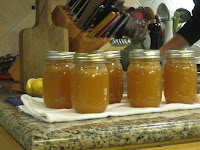
When did this canning obsession start?
I remember making strawberry jam with my great-grandmother Agatha, a compact woman with a commanding bosom. Her son, my great-uncle Arthur had a small farm and brought over produce all summer long. Whole tomatoes, kosher half sours. Sweet pickle chunks. Peaches in syrup - pears, too. Those were days when paraffin was used to seal the jars. We would work all day in her small kitchen. Me, five, maybe six years old, standing on a metal kitchen stepstool so I could see into the pot, and stir and stir. I can still see the narrow white stove. The big preserving pan. The white ceramic big sink. The steps to the cellar, where she stored all the jars. There were stewed tomatoes, pickled tomatoes, beets, watermelon rind and dilly beans.

Flash forward ten years. The parents divorced. We left the town where grandmother and greatgrandmother lived. I lost touch with their kitchens. I lost touch with a lot. I was a teenager, confused, and talking to my mother seemed just impossible. But we could always cook together, my mother and I. And making jam was a dedicated process that would take hours. And that’s where, as cherries were pitted, plums chopped, tomatoes peeled, family stories were told, and where we worked out our differences over the years. I grew up, I created a life in Washington, and she and her husband settled into a home in the Berkshires. But we never stopped cooking together.

Other than mango chutney, a condiment I grew up with, I hadn’t done much canning at my own house. (The mango chutney is like a drug. Once you’ve had it, you can’t imagine life without it, and so I started putting up a few jars of chutney even when I was in college.)
I otherwise left canning to my mother, and raided her larder for raspberry jam, apricot preserves, and jalapeno jelly when I visited. Somehow I thought I would be able to do that forever. And then, a short, gruesome bout with colon cancer, and she was gone. And I’ve been canning at my house ever since. At first, I’m sure I started it all just to evoke her memory. To spend time with her memories. Sort of obvious and I hate being so obvious.

All that sentimentality combined, now, with my desire to eat locally. To support local farmers. To eat organically. To eat no processed foods, other than those I process myself. And canning has become a passion. I’m poring through the stained index cards from great grandmother, both grandmothers, and my Mom, recreating and reinventing, with their whispered assistance.
 I grew Thai chilis last summer and froze them. They work perfectly for the chutney.
I grew Thai chilis last summer and froze them. They work perfectly for the chutney.
Early March is the canning season kick off in this house. It’s right around this time of year the Mexican champagne mangoes come into the market. (I realize this is in complete contrast to all my local eating talk - but really, this chutney is a DRUG.)
I shopped the Asian markets here in DC, where I found a case of mangoes - 20 count - for $9.65 last week. A case will make six pints of chutney, or double the recipe shown below. In our house, where I am the only chutney person, I go through 3 pints a year. I make three extra pints for Christmas presents.

Here is my recipe for
mango chutney, the one I’ve been making for years. It’s up on Food52 and has been since last summer. I have no idea where the recipe came from. My mom and I tinkered for awhile, and then I’m sure I did some tinkering over the years, too. This is the one I’ve made for at least 8 years.

I made a batch of my chutney a few days ago. Tried and true. Shortly before I began the chutney, Lizthechef, a Twitter friend & Food52‘er, posted her recipe for
Mama's Mango Chutney. We agreed to each make the other’s chutney.
 on the left -zippy mango & sour cherry. on the right -move over major gray mango chutney
on the left -zippy mango & sour cherry. on the right -move over major gray mango chutneyLiz, I’m here to confess. I started to make yours, but then that little Recipe-Adapter-Devil got into me, and here’s what I came up with.

Zippy Mango and Sour Cherry Chutney
Makes 3 pints
5 c very ripe champagne mangoes and the juices, diced (from 10 mangoes)
1 medium onion, diced
2 garlic cloves, slivered
1/2 c crystallized ginger
1/2 c golden raisins
1/2 c dried sour cherries
1 tsp mustard seed
1/2 tsp kosher salt
1 c apple cider vinegar
1 c brown sugar
3 super hot thai chilis, pierced with the tip of your paring knife
Put everything into a bowl, stir, and cover. Refrigerate overnight to let the flavors bloom. The next day, put the mixture into a non-reactive preserving pot and bring to a boil, stirring constantly.
Turn the heat down and simmer, uncovered, stirring regularly and gently, for 45 minutes.
The chutney will get thicker, but try not to let the mango pieces break down too much.
(You must put the chutney in jars and process at this point. If you aren’t able to, cover and cool, and when you get back to it, bring to a full boil, then simmer for 10 minutes before processing.)
Tomorrow: Samosas Inside Out - a perfect foil for this chutney.

In the meantime, as this is our first canning project together, I’ll walk you through the processing part:
Before you even start to think about the mangoes, get out your big deep stockpot. You’re going to need a rack of some sort on the bottom. You can use a rack like this, made from canning rings:

Or a piece of non-skid material. Or maybe your pot came with a rack. However you create a cushion, you just don’t want the glass jars banging around on the bottom of the pan.
So, fill the pot with enough water to submerge your jars, and bring it up to a boil.
You’ll need three pint jars or six half-pint jars, rings and new lids with the rubber rings. The rings can be reused as long as they aren’t rusty or dented. You’ll need new lids every time. Lids are readily available in hardware stores and some grocery stores, especially early in the canning season. In 2008, there was a late-season shortage and some tomato canners were freaked.
Put the glass jars in the deep stockpot and boil them.
Now, go back and make the chutney.

When the big stockpot with the jars is boiling like mad, set the timer for 20 minutes, and keep boiling, after which your jars are sterilized. This rough boil also will out any jars with cracks - they’ll split open BEFORE you fill them, in other words. A much better arrangement.
After sterilization, leave them in the covered pot and keep the water barely simmering until the chutney is ready.
Note: If you have a dishwasher, some have a setting for a short wash, or a sterilizer, which is very useful.
When your preserves is simmering away, about 15 minutes before it’s done, put the rings in a small saucepan filled with water, and get that boiling, too.
When the chutney is done, give it a good stir and turn off the heat, and let it sit for no more than 5 minutes before filling the jars.

In those five minutes:
Remove the glass jars from the hot water using your jar lifter, place them upside down on a clean kitchen towel.
Turn up the heat on the big stockpot and add 3-4 T of white vinegar. This will keep your jars all sparkly and the minerals in your water from making spots.
Turn off the heat under the small saucepan, take it off the heat, and add the lids with the rubber ring. You don’t want to boil the rubber rings, just place them in hot water so the rubber will more readily form a seal on the glass jar.
Flip the jars over.
 I forgot this handy item in the list of must-have tools. Jar filling funnel. Hardware stores.
I forgot this handy item in the list of must-have tools. Jar filling funnel. Hardware stores.
Now, ladle the ingredients into your jars, filling to 1/2” from the top. Any extra leftover goes into a little bowl for the cook. Don’t overfill, or your seal will fail.
 Fill to the first ridge on the neck of the jar, that's 1/2" on any canning jar.
Fill to the first ridge on the neck of the jar, that's 1/2" on any canning jar.
Wipe the jars, rim and all the threads well with a damp, clean kitchen towel.
Using the metallic lid lifter, or a pair of tongs, get the rubberized lids and place them on the jars.
Finger tighten the rings on each jar.
Using your jar lifter, lower the jars into the stockpot. Settle them on the rack, sitting upright. If the water doesn’t cover the jars by 2”, add more (I often use the already hot water that I heated the lids in.) Cover and get the water boiling - really boiling - again.

Counting from the time the water is boiling hard, process 10 minutes, for 1/2 pints or 20 minutes for pints.
After the processing is complete, turn off the heat and lift out the jars. Place them on a folded towel on the counter - never place hot jars on a cold stone counter - and listen. You’ll hear the seals pop. It’s a satisfying sound. And it means you’ve safely canned.
Don’t fiddle with your jars for several hours, if possible. Place them where they will be undisturbed. Then put them on the shelf and stare at them lovingly. Try not to hoard.

 snacks: cheese crackers, duck liver terrine, rice crackers, new Spring fromage,
snacks: cheese crackers, duck liver terrine, rice crackers, new Spring fromage, Saturday morning the hyacinths all bloomed. intoxicating aroma.
Saturday morning the hyacinths all bloomed. intoxicating aroma. roasted golden beets and ricotta salata over baby arugula with horseradish dressing
roasted golden beets and ricotta salata over baby arugula with horseradish dressing Sunday morning, 7am, Washington, DC Tidal Basin - Cherry Blossoms
Sunday morning, 7am, Washington, DC Tidal Basin - Cherry Blossoms Sunday brunch: apricots & yogurt, Kaki's Strangled Eggs, scones,
Sunday brunch: apricots & yogurt, Kaki's Strangled Eggs, scones,
















































